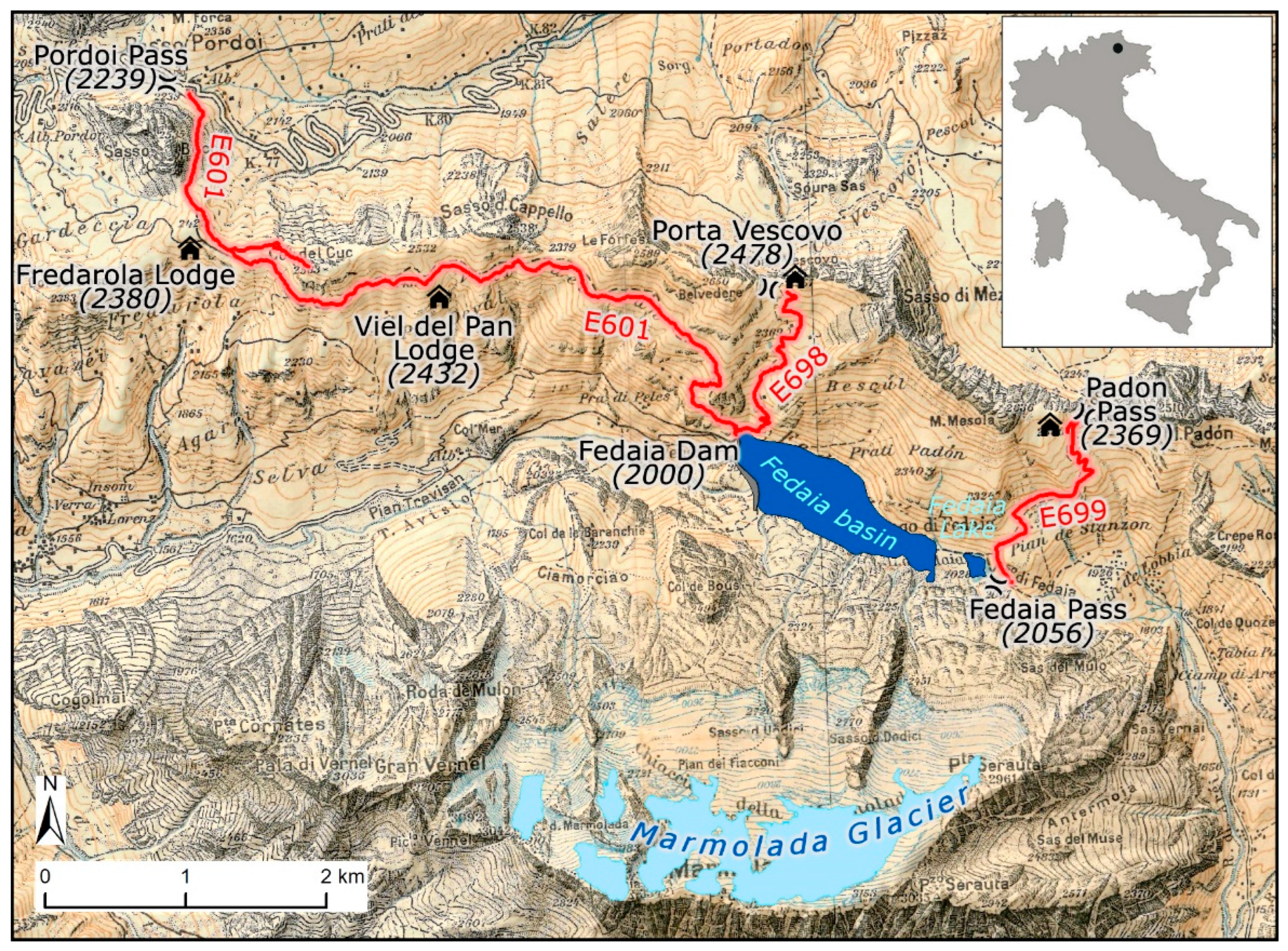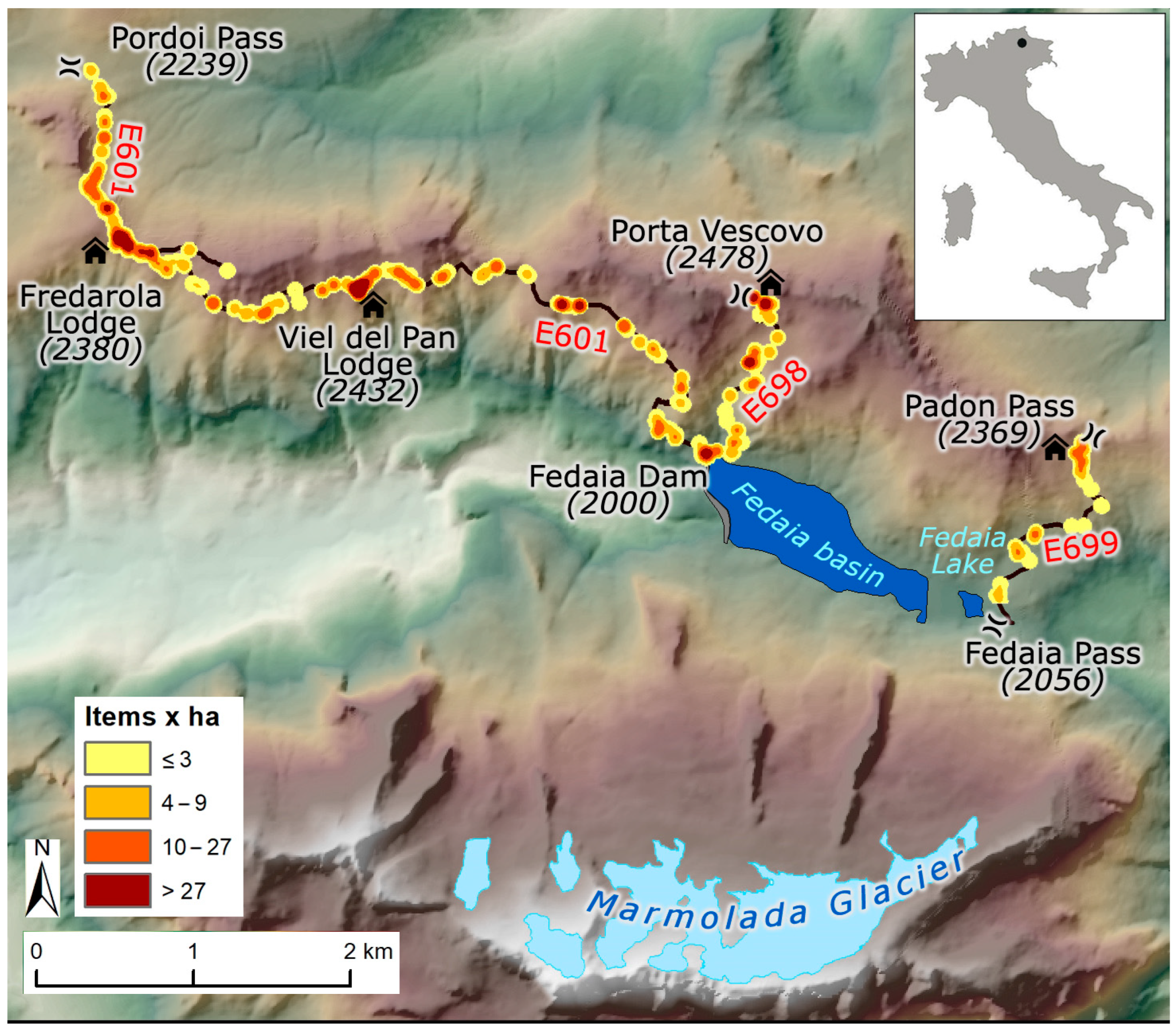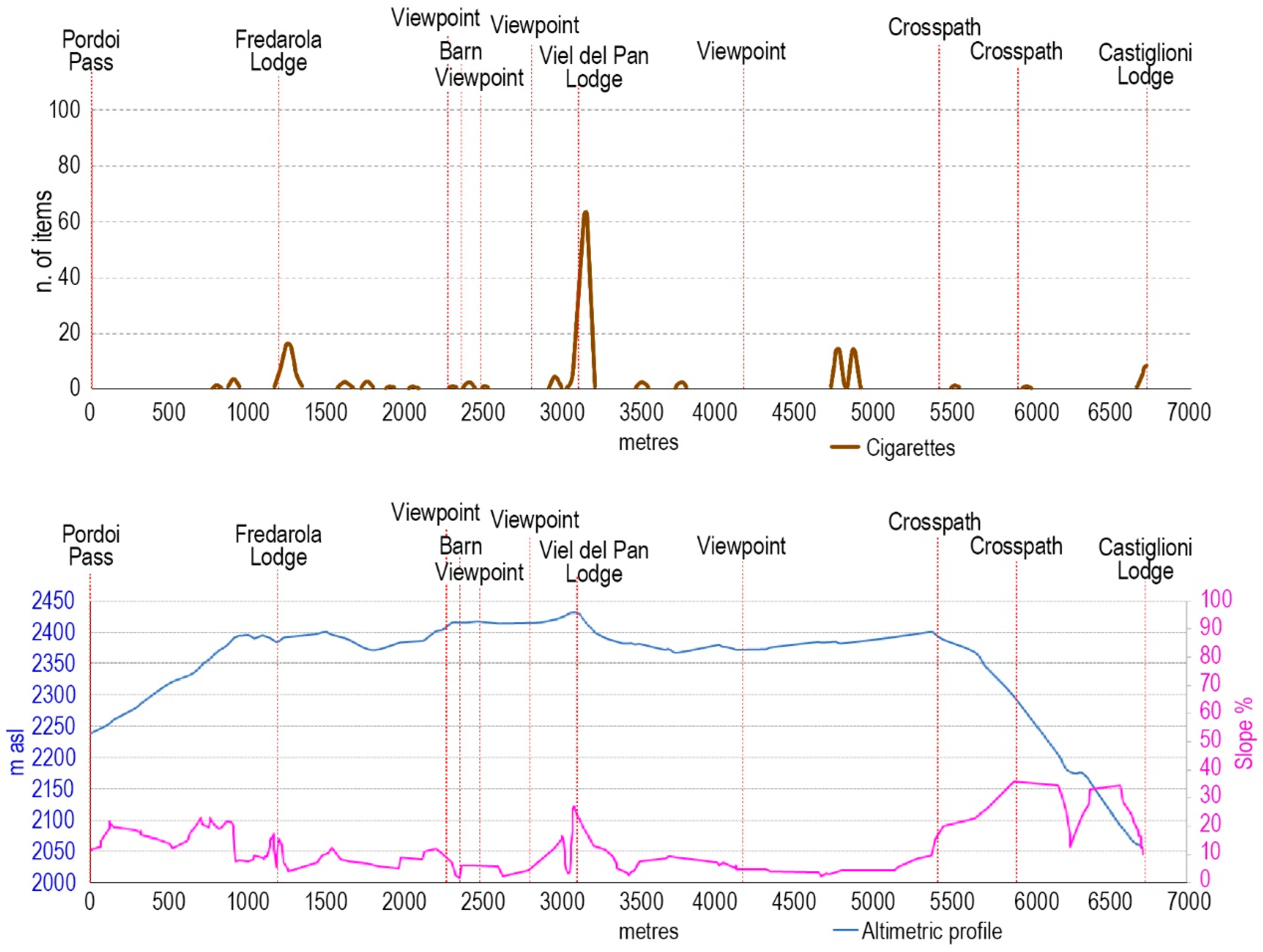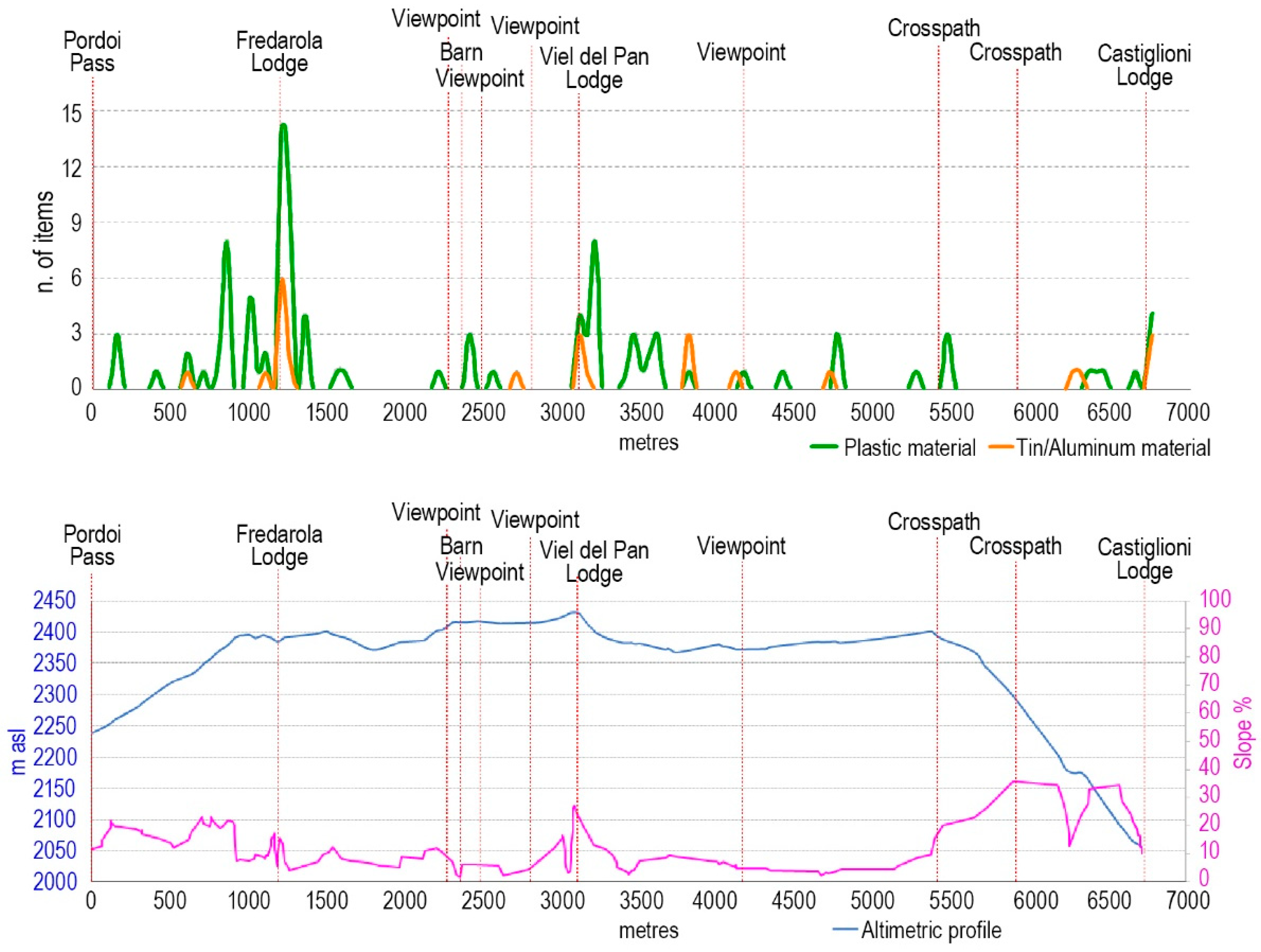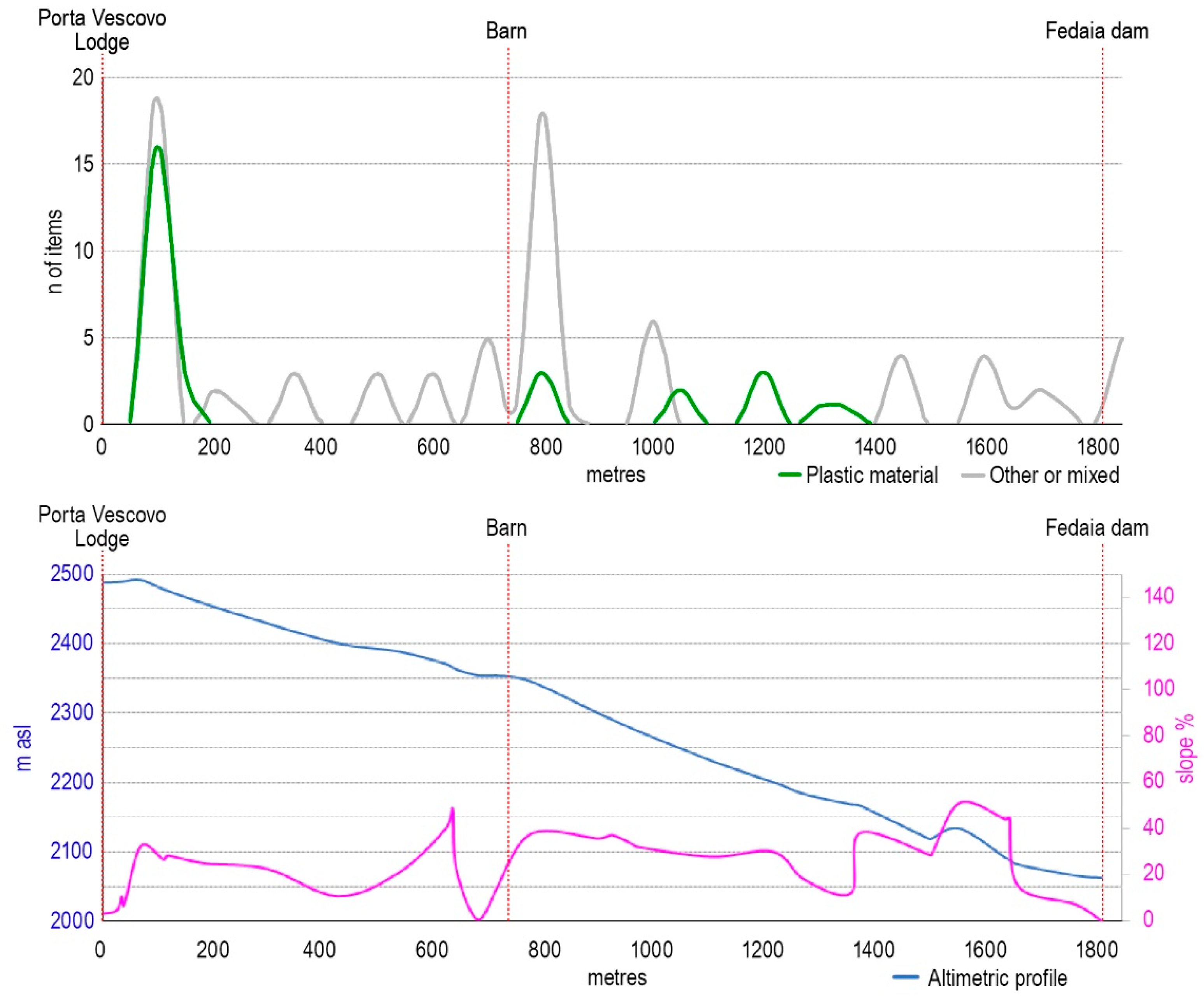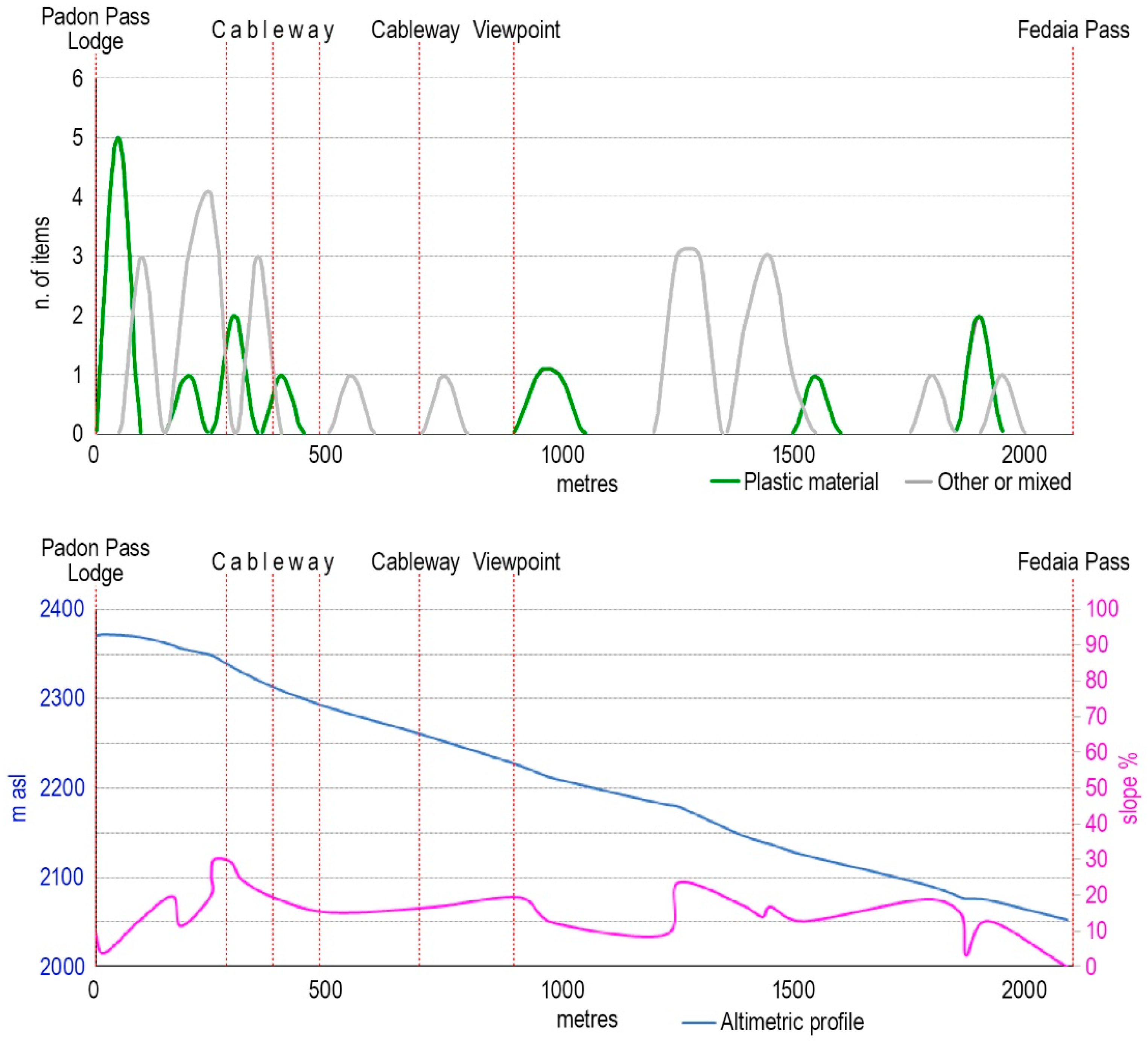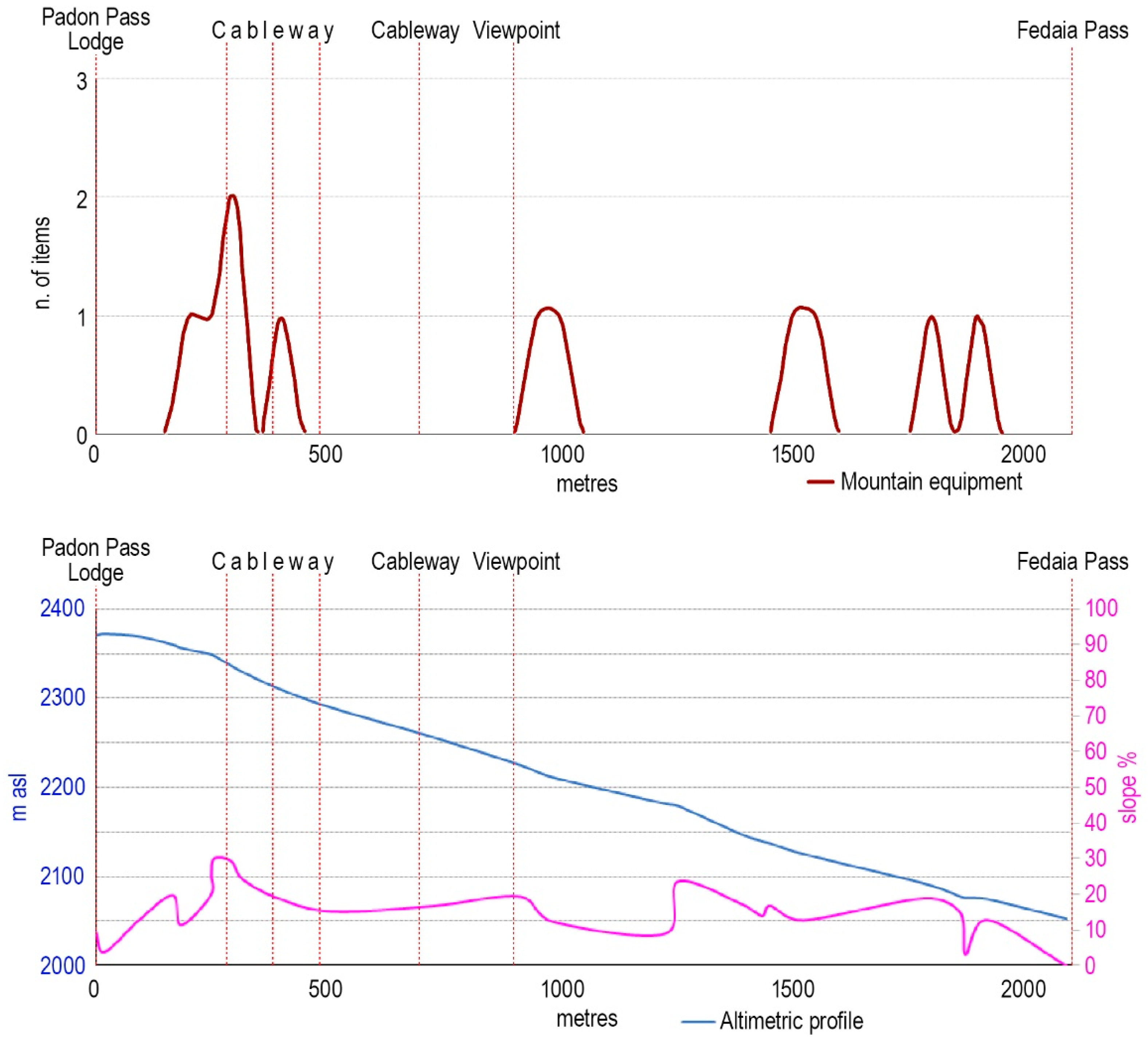1. Introduction
Environmental pollution in terrestrial ecosystems is a persistent problem that poses a risk for the delicate balance of fragile habitats and human systems, including in remote mountain areas [
1]. The increasing popularity of mountains as tourism and entertainment destinations carries potential consequences for the sensitive mountain environment [
2]. In these high-altitude areas without permanent settlements, the pollution mainly stems from mountain tourism activities, such as climbing, trekking, hiking, and skiing [
3,
4]; consequently, air, water, soil, and landscape are at risk of degradation [
5]. Mountaineering activities exert various effects on the high mountain natural environment, encompassing alterations in land relief, in fauna and flora, and pollution [
5]. The human-induced effects on highlands imminently entail implications downstream; thus, mitigating anthropogenic impacts on mountains is paramount.
Tourists, trekkers, and mountaineers litter the highland routes, whether voluntarily or involuntarily, with food packaging, cans, plastic bottles, paper, and other solid waste materials as well as by open defecation and urination [
2,
6]. At this macroscopic level, it is easy to attribute the presence of waste items to tourists and mountaineers [
1], and the lodges, mountain huts, and base camps often lack appropriate solutions to address this waste generation and pollution [
2]. In this regard, tourism constitutes an important source of macro-, meso-, and microplastics in remote mountain areas given the types of waste left behind by mountaineers and tourists [
1,
7,
8,
9]; the situation in the Italian Alps is no exception.
In recent years, in line with the global trends, several studies on plastic contamination of glaciers, snow, lakes, and trails in the Western and Central Italian Alps have been conducted [
1,
9,
10,
11,
12]. However, during the literature research, we did not come across any relevant study that focused on the mapping of tourism-related solid waste in high mountain environments. Hence, this study is based on the Dolomites, a UNESCO (United Nations Educational, Scientific and Cultural Organization) World Heritage Site, a mountain range in the northeastern Italian Alps hosting 18 peaks that soar beyond 3000 m and encompass 141,903 hectares [
13]. This World Heritage Site is described by UNESCO as “
a serial property of nine areas that present a diversity of spectacular landscapes of international significance for geomorphology marked by steeples, pinnacles and rock walls, the site also contains glacial landforms and karst systems” [
13]. Given this status, it is no wonder that the Dolomites are widely regarded as one of the most captivating mountain landscapes on the planet [
13]. Belluno and Trentino provinces host the most famous attractions and popular destinations of the Dolomites range: according to the official statistics from for the year 2022 in mountain destinations, they collectively recorded 5,318,186 arrivals and 20,749,249 tourism nights, with the peaks occurring in the month of August [
14,
15]. To illustrate, in the Tre Cime di Lavaredo site, one of the most famous attractions of the Dolomites (part of UNESCO Zone 5 ‘Dolomiti Settentrionali’), it is revealed that over 51 days there was an average of 3998 visitors, tripling during the peak days: on 15th of August there were 13,467 visitors recorded (a density level of 75 people per hectare) [
16], showcasing the problem of mass tourism in the Dolomites. Given this context, it becomes crucial to measure the environmental impact generated by this massive human presence on the fragile mountain environment.
Thus, the purpose of this work is to assess the extent of littering at a target destination for mass tourism of mountaineering and to detect any patterns and characteristics to identify potential strategies or contrasts. This study does not concentrate on regular waste generation in hot spots, i.e., hotels, base camps, or dumpsites, but rather on the littering spread along kilometers of trails and off tracks by mountaineers and tourists. To this end, the citizen science approach enabled faster and broader data collection coverage in the study area. Literature research confirmed the pertinence of this choice since previous studies have cited and utilized citizen science as a potential resource for the monitoring, tracking, and reporting of plastic contamination in high-altitude remote areas [
12,
17,
18]. Moreover, new computational resources, such as web applications based on geographic information systems (GIS), photo upload and validation, and simple online and offline data feeds [
19], played a crucial role in this citizen-science-based research.
Overall, the outcome of this study underscores the prevalence of plastic pollution and investigates various littering patterns along three popular trails on the Veneto–Trentino border area of the Dolomites. The visualization and mapping of the macroscopic waste along the trails by using GIS-based software allow for a better understanding of the scale, impacts, and patterns of tourism-related littering and create room for drawing recommendations for the sustainable future of mountaineering in this area.
2. Materials and Methods
This study was conducted on three hiking trails in the Dolomites in Northeastern Italy, located on the boundary lines of Veneto and Trentino-Alto Adige regions, and they are easy-to-access historical mountaineering destinations with the iconic Marmolada glacier view (UNESCO Zone 3 ‘Marmolada’) to their south (
Figure 1). According to the trail identification codes of Club Alpino Italiano (CAI) (Italian Alpine Club in English), the trails are labeled as:
E601, also known as ‘Viel del Pan’, from Pordoi Pass to Lake Fedaia (trail length 6721 m), is part of Alta Via (high route in English) #2 of the Dolomites—recognized as the “way of the legends” since it crosses through the mountains and valleys rich in myths and legendary stories. It is a popular destination for trekking and hiking for all types of mountain visitors, given the easy access by bus, car and cableway, and trail characteristics (referred in sub-section E601 (Viel del Pan) in Results).
E698, from Fedaia Dam to Porta Vescovo Lodge (trail length: 1813 m), is a popular destination among hikers and experienced mountaineers who aim to reach the ‘via ferrata delle Trincee’ from Fedaia Pass. There is also a cableway near Porto Vescovo Lodge that arrives from Arabba.
E699, from Fedaia Pass to Padon Pass (trail length: 2087 m), mostly follows a ski slope and a cableway; therefore, it can be impacted by winter tourism as well, and it is popular among all types of mountain visitors.
The rationale behind the selection of trails is that they represent typical, famous mountaineering destinations in the Dolomites since they are accessible by various means of transport and they attract all types of mountaineers and tourists throughout the year, ranging from professionals to recreational mountaineers to novice tourists [
3] to families.
Data collection occurred in the summer of 2022 (26 to 28 August) with the participation of university students within the scope of Summer School MIRIAD—Misurazione Impatto Rifiuti Antropici Sulle Dolomiti (Measurement of the Impact of Anthropogenic Waste in the Dolomites in English). The team hiked on the trails detecting and collecting macroscopic waste materials, simultaneously filling an offline form on electronic devices (mainly smartphones) through Open Data Kit (ODK) Collect for the identification and geo-location of each waste material found. The offline form consisted of specific information on the geographical position, number, COVID-19 relativity, usage, and material type of the waste items. The geographical position was captured automatically by the GPS (global positioning system) of the devices used; in addition to this, the participants were required to manually enter the location of the waste item as on the trail, around the trail (with a 2 m range), or off the trail. The number of waste items was grouped under the ranges of 1, 2–3, 4–5, 6–10, and 10+ per data entry, and the usage of waste items was grouped under the categories of mountaineering equipment, clothing, beverage/drink bottle, food packaging, face mask, wet wipe/napkin, and other. The material type of waste items was grouped in a simplified way under the categories of plastic, tin can/aluminum, glass, paper/cardboard, fabric/tissue, mixed, and others. The waste items were photographed in loco where possible. The data set was stored primarily on ONA Data, and then extracted to Excel for data sorting. The initial data set had 293 entries, and after data sorting, the entries amounted to 257. The sorted data were later applied to GIS (geographic information system) software, Esri GIS ArcMapTM, for mapping and analysis.
At the outset, two one-dimensional maps with bookmarks for each of the trails had been produced: one with the exact GPS locations of the waste items, and one with all GPS locations adjusted on the trail on a linear base. The primary analysis regarding the distribution and concentration of the waste items along the trails according to their usage or material type was performed by mapping them visually on the software. To facilitate the presentation of the primary analysis, three single maps were created, retracing all three trails with bookmarks of waste items adjusted on a linear base. Additionally, the map with littering density per hectare was produced (presented in
Figure 2). Moreover, we calculated the distribution of total number of waste items with the maximum and average number of waste items encountered every 50 m for each trail and their standard deviation (presented in
Table 1). In connection to this, in order to better evaluate the patterns of littering and density, we created graphs for the distribution of waste items every 50 m according to the material type and usage classification for each trail. The choice of distribution analysis every 50 m is based on the aim of illustrating the results that closely align with reality while maintaining a range suitable for compensating the possible GPS errors. In total, 21 graphs were created: 8 graphs for E601; 7 graphs for E698; and 6 graphs for E699.
For the purposes of this work, the presentation of the results is limited to two graphs per trail indicating the significant patterns and their interpretations.
3. Results
Although littering is found to be prevalent all along the trails (illustrated in
Figure 2), several littering patterns are identified based on the density of waste items and their usage classification and material type for each trail. Due to this reason, the results are presented separately per trail analyzed.
In a nutshell, according to the density analysis (
Figure 2) and numerical distribution data (
Table 1), E601 ‘Viel del Pan’ appears as the most contaminated among the three trails, and this is a foreseeable result since it is also the longest and most popular trail among the three. It is followed by trail E698, which demonstrates a lower level of contamination compared to trail E601 and a slightly higher level compared to trail E699; in other words, trail E699 shows the lowest level of contamination. All the trails show a concentrated distribution of waste items in a few hot spots. However, in between these hot spots, waste occurrence follows a rather causal distribution yet still presents catchable patterns. These are the two phenomena that will be subject to discussion specifically for each of the trails analyzed.
3.1. E601 (Viel del Pan)
The trail ‘Viel del Pan’ follows a historical commerce path that connected the merchants across the valley from Pordoi Pass to Fedaia Pass. In present times, it remains a popular destination for trekkers and hikers in the Italian Dolomites, and it is characterized by a constant slope and altimetric profile in the central part while featuring a significant slope and altimetric change towards Fedaia Pass, as illustrated in
Figure 3. The altimetric and slope change profile plays a crucial role in the trail’s popularity among hikers, tourists, and mountaineers as it provides an easy difficulty level. The length of the trail is approximately 7 km (6721 m), and the estimated time of this hike (one way) is 2 h and 30 min. Along the trail, there are two lodges with restaurants and sanitary services, as well as several easily recognizable cross paths and viewpoints (see
Figure 3).
The team registered 542 pieces of waste items in total, and after careful analysis, the first pattern highlights the problem of smoked cigarette butt littering (
Figure 3). Out of the 542 waste items, 202 are found to be smoked cigarette butts encountered throughout the trail, and this number corresponds to 37.3% of the total waste items. Moreover, the concentration of cigarette butts indicates a significant ‘lodge effect’, where people have a long break and light up a cigarette. This pattern, despite the existence of trash bins around the lodges, signals voluntary littering behavior by hikers and trekkers.
The second pattern (
Figure 4) draws attention to the plastic and tin/aluminum littering along the trail: Out of the 542 waste items, 133 of them are made of plastic and tin/aluminum (108 plastic and 25 tin/aluminum), and this number corresponds to 24.5% of the total waste items. The concentration pattern of plastic and tin/aluminum reiterates an overall ‘lodge effect’ with implications for voluntary littering. Moreover, there appears a viewpoint and cross-path effect, where traces of short breaks by hikers and tourists to enjoy the landscape and have quick snacks are visible: the prevalence of food packaging, bottles, and cans at viewpoints and cross-paths conforms to this. Littering at these spots suggests voluntary littering once more; however, littering along the path hints at involuntary littering as the items might have dropped from pockets and backpacks on the way. The littering along the trail should take into consideration the probability of atmospheric transport [
1,
10,
20]; however, detecting this effect proves to be challenging.
3.2. E698
The trail ‘E698’ connects Fedaia Dam to Porta Vescovo Lodge, and it is characterized by a constant slope and significant altimetric changes from the beginning to the end. The length of the trail is slightly less than 2 km (1813 m), and the estimated time of this hike (one way) is 1 h and 15 min. It is an open valley with nearly no tree vegetation, and there is only an old, abandoned barn in the middle of the trail that can be utilized as an emergency shelter for trekkers, mountaineers, and shepherds.
A total of 111 waste items were registered, with 32 of them being plastics, corresponding to 28.9% of the total waste. The first pattern identified showcases the plastic littering with yet another ‘lodge effect’ and the parallel concentration of others, mostly cigarette butts and napkins, at the beginning of the trail (
Figure 5).
The second pattern points to the prevalence of napkins and wet wipes throughout the trail (
Figure 6). Out of 111 waste items, 46 of them are napkins and wet wipes, corresponding to 41.4% of the total waste. Furthermore, the concentration of napkins and wet wipes around the barn demonstrates a significant ‘open-air toilet effect’ for hikers and tourists (
Figure 6). The open valley and the absence of any toilet infrastructure in between designate the surroundings of the barn for nature’s call emergencies; however, the choice of leaving traces behind flags voluntary littering.
3.3. E699
The trail ‘E699’ connects Fedaia Pass to Padon Pass, starting from the parking lot at Fedaia Lake and ending at the lodge at Padon. The trail shows a constant slope and significant altimetric changes since it mostly retraces a ski slope; the length of the trail is approximately 2 km (2087 m), and the estimated time of this hike (one way) is 1 h and 15 min. Right next to the lodge, there exists a ski lift/cableway that is operational during the summer as well.
On this trail, the lowest number of waste items was registered, with a total of 43. Out of these 43, 14 of them are plastics, corresponding to 32.5% of the total waste (
Figure 7). The first pattern indicates the problem of plastic littering, especially that of hard durable plastics. This stems from the fact that a significant portion of plastic littering on this trail originates from technical ski or mountaineering equipment: 11 out of 14 plastic items are categorized as mountain equipment (
Figure 8); thus, its share amounts to 25.6% of the total waste items.
The distribution pattern and prevalence of mountaineering equipment reveal a distinct ski slope and cableway effect (
Figure 8), indicating involuntary littering. This littering results from waste items dropped from the cableway and landing on the ground. However, there arises a need for regular cleaning and maintenance to prevent the accumulation of hard plastics.
4. Discussion
The outcomes of this study contribute to the sustainability of mountaineering tourism since an evidence-based basis leads us to reflect on the repercussions of voluntary and involuntary littering behavior of mountaineers and tourists, and the impact of different waste types on the sensitive mountain environment.
To begin with, the striking density and number of smoked cigarette butts encountered along the trails deserve specific attention. Amongst the public, there is a general misconception about the material composition of cigarette filters, which are believed to be biodegradable in nature [
21]. This misconception may lead to the underestimation of the impact of cigarette littering by mountaineers and tourists. Despite this misconception, cigarette butts persist for many years in the natural environment since they are made of plastic-like cellulose acetate, and their decomposition can take up to decades depending on the environmental factors in play [
22,
23]. In this decay process, the discarded cigarette butts not only contribute to visible pollution but additionally contribute to the generation of microplastics, concurrently releasing toxic constituents from the filter or tobacco remains into the environment [
21,
22].
Moreover, the abundance of sanitary products, such as napkins and wet wipes, in a few areas indicates defecation and micturition and therefore an ‘open-air toilet effect’ is worth reflecting upon. In high mountain settings, particularly on trekking or hiking paths, due to the lack of proper infrastructure, tourists and mountaineers resort to open defecation and micturition. Human feces are a natural phenomenon, but they contain over 100 bacteria, protozoans, and viruses that pose a threat to animal and human health if not handled without special recycling methods [
24,
25]. It is critical to recall that pathogen disposal and contamination stemming from open defecation not only have implications for the mountain environment but also for the downstream areas [
24,
25]. In line with this, the accumulation of napkins and wet wipes in the surroundings of open toilet spots leads to visible pollution, and their decomposition adds up to microlevel pollution. While toilet paper and napkins made of cellulose (a natural polymer) can break down easily, especially if buried [
26], disposable wet wipes are nonwoven fabrics based on plastic fibers, making them resistant to easy degradation. However, during their breakdown, they release micro- and nanoplastic particles, contributing to microplastic pollution [
27,
28].
Additionally, terrestrial plastic pollution emerges as a distressing reality, considering the proportion of plastic and plastic-like items in the outcomes of this study. Plastics accumulate and persist in the environment for a long time due to their molecular composition and the chemical processes they undergo during production [
29]. Certainly, different types of plastics demonstrate varying degradation rates and time spans depending on their size, material properties, and reaction conditions in nature [
29]. In this study, the plastics encountered range from small pieces of food packaging to very durable mountaineering equipment; however, their accumulation and persistence remain a common reality. In this regard, the outcomes on plastics and plastic-like items encountered in this study show resembling results compared to the work of Parolini et al. (2021) on macroplastic contamination on glaciers in the Italian Central–Western Alps, illustrating the types of macroplastics on seven transects (along access paths) reaching peaks of five glaciers in the Piedmont and Lombardy regions [
1].
Furthermore, tourism-related littering and pollution in the mountain environment have become of notable concern since the decomposition is slowed down due to the extreme climatic conditions for all [
26,
30]. Consequently, the accumulation and persistence are extended for a longer period of time in alpine environments.
Based on the study outcomes, there also arises a need for embarking on a quest for possible recommendations for improvement in the study area for a sustainable future:
A call for enhanced supervision of the accommodation and mobility infrastructure (lodges and cableways) for better waste management, cleaning, and maintenance of surroundings,
Raise awareness on-site on the detrimental impacts of littering and its scale in extreme environments from montane to alpine to discourage people from depositing waste [
25]. This can be achieved through awareness panels placed at the tourist information offices and along the trails promoting the principles of ‘leave no trace behind’ and ‘carry-in, carry-out’. The scale of the problem can be effectively communicated by monitoring of the waste disposal using simple applications with an interactive real-time GIS portal for the area, promoted by public and private actors and involving the citizens in the process,
For unintentional littering along trails, a call for the manufacturers of technical mountaineering equipment to reevaluate their design on clothing and backpacks to provide securely closable zippers for pockets and other compartments to prevent items from falling out accidentally.
Finally, it is crucial to acknowledge the need for continued research and more action in this field to address the sustainability in mountaineering tourism in its fullest sense. Further studies should be conducted on the underlying causes of littering, behavioral and motivational factors, visitor profiles, socioeconomic and cultural profiles of the area, the long-term impacts of littering on the mountain environment, and innovative solutions while fostering collaboration among public and private stakeholders. To illustrate, considering the scope of this research, it is necessary to further investigate whether the level of “mountaineering culture” and “visitor profile” demonstrated by the hikers has an impact on the patterns of littering: do the trails frequented only by experienced mountaineers in remote locations exhibit the same littering patterns as those found on trails that are also accessible to mainstream visitors? In order to test this hypothesis, it would be essential to map and analyze the littering pattern along a destination that is subject to over-tourism in the Dolomites [
16] and to compare it to a trail that is reserved only for experienced mountaineers in the same area. In this regard, the CAI trails E101, a mainstream path, and E117, requiring technical equipment and relative experience for a via ferrata (), may emerge as promising destinations since they also originate from the same starting point: the Auronzo Hut located on Alta Via #4 of the Dolomites (UNESCO Zone 5 ‘Dolomiti Settentrionali’). This exemplification leaves the door easily open for further research with clear directions.
5. Conclusions
Mountain wilderness has vanished from the natural environment of the Dolomites, and nowadays it is highly anthropized with the only exception of the Eastern UNESCO Zone 4 ‘Dolomiti Friulane e d’Oltre Piave’ [
31]. Yet, herein, the challenge for sustainability comes to the forefront: to limit incremental modifications to the natural environment induced by the increasingly invasive (in time and space) presence of humankind.
This evidence-based research on three well-visited hiking trails in the Dolomites, Northeastern Italy, contributes to the quest for sustainability in human-driven activities by shedding light on the pressing problem of littering in a remote high mountain environment caused by mountaineering tourism. At its core, this study adopts a citizen science approach with the active participation of university students, facilitating the large geographical area coverage within a short time frame while at the same time allowing for detailed and comprehensive data gathering. Moreover, the integration of GIS technology plays a key role in the mapping and analysis of the data to present the findings of this research effectively and visually.
The outcomes highlight various littering patterns along the trails and implications for the sensitive alpine environment:
Accommodation and mobility infrastructure prove to be hot spots for contamination although they are economic stewards of the area, considering the significant lodge effect and ski slope/cableway effect.
Tourism-related littering is prevalent throughout the trails, and plastic contamination and accumulation is concerningly evident: e.g., discarded cigarette butts, plastic, and plastic-like materials, and sanitary products as evidence of open defecation and micturition considering open toilet effect.
The littering hints at both voluntary and involuntary behavior depending on the pattern and effect identified. It is worth bearing in mind that the scale of littering along the highland trails may be underestimated since the waste items have the potential to be carried via atmospheric transport (especially the wind factor) and avalanches downstream into the valleys. At this juncture, we must recall that what occurs in highlands unavoidably has an implication downstream, and therefore mitigating human-induced impacts on mountains holds the utmost importance.
Based on the study outcomes, the recommendations revolve around better supervision of accommodation and mobility infrastructure as hot spots on waste management, cleaning, and maintenance. Concurrently, awareness-raising campaigns in loco on the impacts of littering in fragile mountain environments can be promoted with the help of collective monitoring of waste disposal by a GIS tech-based real-time portal for the area.
Additionally, if it holds true that the littering in between the hot spots is rather random, and therefore probably caused by accidental droppings and carelessness, then we call on mountaineering equipment manufacturers to reconsider their designs on clothing and backpack products by adding secure zips for the pockets and compartments.
The vitality of mountaineering tourism holds prime importance for the socio-economic development of the area; however, it is crucial to ensure that such tourism is executed in a sustainable manner. In this regard, the sustainability prospects hinge upon continued research, action, and innovation while simultaneously promoting collaboration among the stakeholders.
Author Contributions
Conceptualization, S.E.Ö. and A.L.; methodology, S.E.Ö., A.L. and F.F.; software, S.E.Ö. and F.F.; validation, F.F.; formal analysis, F.F.; investigation, S.E.Ö. and A.L.; resources, S.E.Ö. and A.L.; data curation, S.E.Ö. and F.F.; writing—original draft preparation, S.E.Ö. and A.L.; writing—review and editing, S.E.Ö., A.L. and F.F.; visualization, S.E.Ö., A.L. and F.F.; supervision, A.L. and F.F.; project administration, A.L.; funding acquisition, A.L. All authors have read and agreed to the published version of the manuscript.
Funding
This research received no external funding.
Institutional Review Board Statement
Not applicable.
Informed Consent Statement
Not applicable.
Data Availability Statement
The data presented and mentioned in this study are available on request from the corresponding author and soon on
https://researchdata.cab.unipd.it/ (accessed on 29 August 2023).
Acknowledgments
We acknowledge the support of the Jean Monnet Excellence Centre on Climate Justice at the University of Padova, namely Massimo De Marchi, Eugenio Pappalardo, and Daniele Codato for their technical assistance. We acknowledge the insights and inspiration from Mauro Varotto from the Geography Museum of the University of Padova, who participated in the project. The authors also acknowledge the valuable contribution of the students at University of Padova attending the Summer School MIRIAD—Misurazione Impatto Rifiuti Antropici Sulle Dolomiti (Measurement of the Impact of Anthropogenic Waste in the Dolomites in English)—for the data collection on site. This research article is inspired by the insightful Erasmus+ Project IFI (Innovative Finance Inclusion in Academia and Field) number 619453-EPP-1-2020-1-IL-EPPKA2-CBHE-JP, funded by the European Commission, which enhances sustainability. Lastly, we would like to thank the anonymous reviewers for their valuable comments on the earlier version of this manuscript.
Conflicts of Interest
The authors declare no conflict of interest.
References
- Parolini, M.; De Felice, B.; Lamonica, C.; Cioccarelli, S.; Crosta, A.; Diolauiti, G.; Ortenzi, M.; Ambrosini, R. Macroplastics contamination on glaciers from Italian Central-Western Alps. Environ. Adv. 2021, 5, 100084. [Google Scholar] [CrossRef]
- Manandhar, D.R.; Hansson, H.; Svensson, H.; Hogland, W.; Mårtensson, L.; Mathiasson, L.; Khanal, S.N. Environmental observations of solid waste management at high altitude in Nepal: Case study along trekking route in Sagarmatha National Park. In Proceedings of the Linnaeus ECO-TECH ’10, Kalmar, Sweden, 22–24 November 2010. [Google Scholar] [CrossRef]
- Apollo, M.; Andreychouk, V. Mountains, humans and mountaineering adventure activities. In Mountaineering Adventure Tourism and Local Communities: Social, Environmental and Economics Interaction; Edward Edgar Publishing: Glos, UK, 2022; pp. 1–26. [Google Scholar] [CrossRef]
- Zeng, L.; Li, R.Y.M.; Nuttapong, J.; Sun, J.; Mao, Y. Economic development and mountain tourism research from 2010 to 2020: Bibliometric analysis and science mapping approach. Sustainability 2022, 14, 562. [Google Scholar] [CrossRef]
- Apollo, M. Environmental Impacts of Mountaineering; Springer Briefs in Environmental Science; Springer Nature: Cham, Switzerland, 2021; pp. 1–59. [Google Scholar] [CrossRef]
- Alfthan, B.; Fouinat, L. Plastics on the Peak: The 2021 Global Mountain Waste Survey; GRID-Arendal: Arendal, Norway, 2022; ISBN 978-82-7701-208-7. [Google Scholar]
- Xiong, X.; Zhang, K.; Chen, X.; Shi, H.; Luo, Z.; Wu, C. Sources and distribution of microplastics in China’s largest inland lake—Qinghai Lake. Environ. Pollut. 2018, 235, 899–906. [Google Scholar] [CrossRef] [PubMed]
- Li, C.; Busquets, R.; Campos, L.C. Assessment of microplastics in freshwater systems: A review. Sci. Total Environ. 2020, 707, 135578. [Google Scholar] [CrossRef] [PubMed]
- Parolini, M.; Antonioli, D.; Borgogno, F.; Gibellino, M.; Fresta, J.; Albonico, C.; De Felice, B.; Canuto, S.; Concedi, D.; Romani, A.; et al. Microplastic contamination in snow from western Italian alps. Int. J. Environ. Res. Public Health 2021, 18, 768. [Google Scholar] [CrossRef]
- Ambrosini, R.; Azzoni, R.S.; Pittino, F.; Diolaiuti, G.; Franzetti, A.; Parolini, M. First evidence of microplastic contamination in the supraglacial debris of an alpine glacier. Environ. Pollut. 2019, 253, 297–301. [Google Scholar] [CrossRef]
- Pastorino, P.; Pizzul, E.; Bertoli, M.; Anselmi, S.; Kušće, M.; Menconi, V.; Prearo, M.; Renzi, M. First insights into plastic and microplastic occurrence in biotic and abiotic compartments, and snow from a high-mountain lake (Carnic Alps). Chemosphere 2021, 265, 129121. [Google Scholar] [CrossRef]
- Sighicelli, M.; Pietrelli, L.; Lecce, F.; Iannilli, V.; Falconieri, M.; Coscia, L.; di Vito, S.; Nuglio, S.; Zampetti, G. Microplastic pollution in the surface waters of Italian Subalpine Lakes. Environ. Pollut. 2018, 236, 645–651. [Google Scholar] [CrossRef]
- The Dolomites. Available online: https://whc.unesco.org/en/list/1237/ (accessed on 10 August 2023).
- Istituto di Statistica della Provincia di Trento (ISPAT) from Annuario del Turismo Dataset. Available online: https://statweb.provincia.tn.it/annuario/(S(bxr5spzlemr0d255k0xalv55))/tavola.aspx?idt=2.33&t=at (accessed on 29 August 2023).
- Ufficio di Statistica Regione del Veneto Sistema Statistica Regionale from Movimento Turistico nel Veneto Dataset. Available online: https://statistica.regione.veneto.it/jsp/turi2.jsp?D0=2022&D1=STL&D2=0001+Dolomiti&D3=Turisti+italiani+per+regione+di+provenienza&B1=Visualizza (accessed on 29 August 2023).
- Bertocchi, D.; Camatti, N.; Van der Borg, J. Tourism peaks on the three peaks. Using big data to monitor where, when and how many visitors impact the Dolomites UNESCO World Heritage Site. Riv. Geogr. Ital. 2021, 3, 59–81. [Google Scholar] [CrossRef]
- Padha, S.; Kumar, R.; Dhar, A.; Sharma, P. Microplastic pollution in mountain terrains and foothills: A review on source, extraction, and distribution of microplastics in remote areas. Environ. Res. 2022, 207, 112232. [Google Scholar] [CrossRef]
- Kumar, R.; Verma, A.; Shome, A.; Sinha, R.; Sinha, S.; Jha, P.K.; Kumar, R.; Kumar, P.; Shubham; Das, S.; et al. Impacts of plastic pollution on ecosystem services, sustainable development goals, and need to focus on circular economy and policy interventions. Sustainability 2021, 13, 9963. [Google Scholar] [CrossRef]
- Albagli, S.; Iwama, A.Y. Citizen science and the right to research: Building local knowledge of climate change impacts. Humanit. Soc. Sci. Commun. 2022, 9, 39. [Google Scholar] [CrossRef]
- Allen, S.; Allen, D.; Phoenix, V.R.; Roux, G.; Jimenez, P.D.; Simonneau, A.; Binet, S.; Galop, D. Microplastics in a remote mountain catchment. Nat. Geosci. 2019, 12, 339–344. [Google Scholar] [CrossRef]
- Shen, M.; Li, Y.; Song, B.; Zhou, C.; Gong, J.; Zeng, G. Smoked cigarette butts: Unignorable source for environmental microplastic fibers. Sci. Total Environ. 2021, 791, 148384. [Google Scholar] [CrossRef] [PubMed]
- Dobarabadan, S.; Schmidt, T.C.; Lorenzo-Parodi, N.; Joachmann, M.A.; Nabipour, I.; Raeisi, A.; Stojanovic, N.; Mahmoodi, M. Cigarette butts: An overlooked source of PAHs in the environment? Environ. Pollut. 2019, 249, 932–939. [Google Scholar] [CrossRef] [PubMed]
- Green, D.S.; Tongue, A.D.W.; Boots, B. The ecological impacts of discarded cigarette butts. Trends Ecol. Evol. 2022, 37, 183–192. [Google Scholar] [CrossRef]
- Apollo, M. The good, the bad and the ugly—Three approaches to management of human waste in a high-mountain environment. Int. J. Environ. Stud. 2017, 74, 129–158. [Google Scholar] [CrossRef]
- Cilimburg, A.; Monz, C.; Kehoe, S. Wildland recreation and human waste: A review of problems, practices, and concerns. Environ. Manag. 2000, 25, 587–598. [Google Scholar] [CrossRef]
- Bridle, K.E.; Kirkpatrick, J.B. An analysis of the breakdown of paper products (toilet paper, tissues and tampons) in natural environments, Tasmania, Australia. J. Environ. Manag. 2005, 74, 21–30. [Google Scholar] [CrossRef]
- Hu, T.; Shen, M.; Tang, W. Wet wipes and disposable surgical masks are becoming new sources of fiber microplastic pollution during global COVID-19. Environ. Sci. Pollut. Res. 2022, 29, 284–292. [Google Scholar] [CrossRef]
- Ó Briain, O.; Mendes, A.R.M.; McCarron, S.; Healy, M.G.; Morrison, L. The role of wet wipes and sanitary towels as a source of white microplastic fibres in the marine environment. Water Res. 2020, 182, 116021. [Google Scholar] [CrossRef] [PubMed]
- Chamas, A.; Moon, H.; Zheng, J.; Qiu, Y.; Tabassum, T.; Jang, J.H.; Abu-Omar, M.; Scott, S.L.; Suh, S. Degradation rates of plastics in the environment. ACS Sustain. Chem. Eng. 2020, 8, 3494–3511. [Google Scholar] [CrossRef]
- Semernya, L.; Ramola, A.; Alfthan, B.; Giacovelli, C. Waste management outlook for mountain regions: Sources and solutions. Waste Manag. Res. 2017, 35, 935–939. [Google Scholar] [CrossRef] [PubMed]
- Orsi, F.; Geneletti, D.; Borsdorf, A. Mapping wildness for protected area management: A methodological approach and application to the Dolomites UNESCO World Heritage Site (Italy). Landsc. Urban Plan. 2013, 120, 1–15. [Google Scholar] [CrossRef]
| Disclaimer/Publisher’s Note: The statements, opinions and data contained in all publications are solely those of the individual author(s) and contributor(s) and not of MDPI and/or the editor(s). MDPI and/or the editor(s) disclaim responsibility for any injury to people or property resulting from any ideas, methods, instructions or products referred to in the content. |
© 2023 by the authors. Licensee MDPI, Basel, Switzerland. This article is an open access article distributed under the terms and conditions of the Creative Commons Attribution (CC BY) license (https://creativecommons.org/licenses/by/4.0/).
